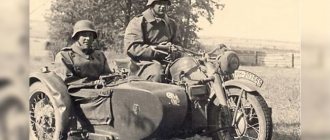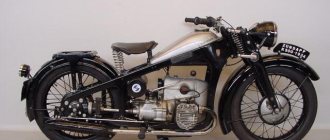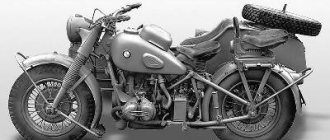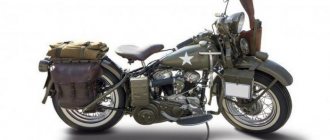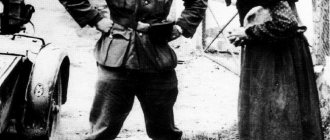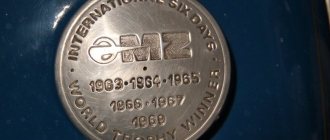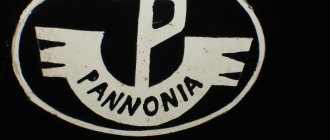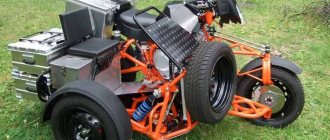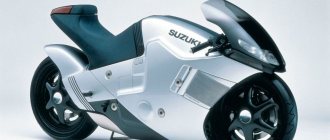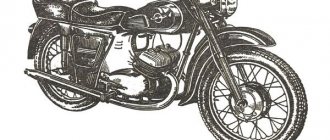It's the May holidays and as a tribute to the feat of our ancestors, I would like to review the motorcycles that took part on the front line and in civilian life. What else, besides motorsports, is developing the motorcycle industry? War and the arms race spurred the development of motorcycles, because even one motor unit can change the course of history.
By the time the Second World War began, German motorcycles had an advantage, so we will begin our review with them.
Let's remember the history course. After the First World War, Germany was humiliated and, according to the treaty, it did not have the right to develop the defense industry to its fullest extent. Citizens of the country could not buy cars that were quite expensive at that time, but a motorcycle was affordable for any ordinary resident of the destroyed country.
The development of motor vehicles received a strong impetus. BMW and the then popular Zundapp entered into competition for primacy in the new market.
BMW switched from the railway spare parts market, and Zundapp, before developing motorcycles, was engaged in the manufacture of projectiles and detonators.
BMW motorcycles
Until 1924, BMW produced civilian motorcycles, the engine of which was copied by the English boxer Douglas, but closer to the 1930s the motorcycle began to acquire familiar features. It was by this time that BMW presented a new modification, called the R32, and the first real military development was the R35.
New items introduced into the design of motorcycles by the 1930s. years:
- Cardan drive instead of chain drive. The cardan is more convenient and safer under military load conditions, requires less cost and wears out less chain
- Telescopic front fork and fork with hydraulic shock absorbers
BMW motorcycle models:
R35
R12
R66
R71
R75
BMW motorcycles were developed with different configurations for transporting weapons, ammunition and transporting the wounded. Separate versions were motorcycles for motorized troops and patrol police. The motorcycles had cases, mounts for guns, even cases for a machine gun. They were distinguished by their large carrying capacity and repairability, and were produced both with strollers and solo singles.
BMW has proven itself to be the best, and even made a splash with the R71 model, which has become universal and one of the most popular.
Harley-Davidson WLA
Harley Davidson WLA 45
A slight modification of an existing civilian motorcycle, the WLA Harley-Davidson was a popular bike among the US military, who used it for police work, reconnaissance and communications. Its headlights were modified from the civilian model to meet military standards, and the WLA was equipped with special brackets for carrying machine guns. Considering that it could reach a speed of 105 km/h, it was one of the fastest motorcycles of the war.
Zundapp motorcycles
KS600
KS750
Zundapp motorcycles, which were more expensive to manufacture, became part of the German army in 1940. The KS750 became one of the most powerful representatives of the Wehrmacht motorcycle troops. The all-terrain model could cross small water obstacles with the engine completely submerged. But the dive had to be short so that the motorcycle would not choke.
The adjustable suspension made it possible to adapt to the difficulties of the route. A sidecar drive and a spare gas tank filter, the essence of which is to help the motorcycle move even with a broken tank.
Zundapp went bankrupt in 1984, but is remembered as a manufacturer of military off-road motorcycles.
Cushman Airborne scooter
Cushman Airborne Model 53
Cushman scooters appeared early in the war and were intended for visitors and employees at large US military bases. Since this model had proven its usefulness, a new version was released in 1944 for use by airborne troops. Like the Excelsior Welbike, the Cushman Airborne was parachuted and reassembled on the ground after landing to make paratroopers more mobile. Some models did not have headlights, but the Cushman was more efficient than the Welbike.
Kattenkrad aka Sd. Kfz. 2
The tip of the iceberg among high-torque motorcycles. Kattenkrad - a tracked motorcycle with a one and a half liter Opel engine replaced the main horse-drawn force, dragging heavy guns and even airplanes. The most heavy-duty type of motorized transport in the enemy army. The obvious disadvantages of this development were difficulties in passing diagonally on a hill, an extremely uncomfortable landing and seat height, due to which the pilot had difficulty leaving his seat in case of trouble. And the Kattenkrad turned over quite often, especially on sharp and sharp turns.
Minsk copy of MMVZ M1M “Minsk” (1951) MACACA…. that's what people called him
0
It was a great motorcycle - beautiful and reliable. In 1951, by order of the USSR Ministry of Automotive and Tractor Industry, M1A production was transferred from Moscow to Minsk to the Minsk Motorcycle and Bicycle Plant (MMVZ). The M1A was produced until 1956, when it was replaced by the modernized M1M model. The easiest way to distinguish the new model is by the different welded front and rear fenders, which received sunsets - a characteristic feature of motorcycles of those times. It is thanks to this feature that the M1M looks much more old-school than the M1A. Like M1A,
4.
DKW - Dampf Kraft Wagen
The Germans came up with their own abbreviation for the motorcycles of this company - Des Knaben Wunsch or, Das Kleine Wunder, which translates as “boys’ dream” and “little miracle”.
Small and nimble motorcycles in the ranks of the German army, with modest dimensions and small engine volumes, became very popular outside the front for their size and efficiency.
RT125
NZ350
The overall result: the consequences of the First World War laid fertile ground in Germany for the successful development of the motorcycle industry and a whole niche of this type of transport. By the beginning of the Second World War and at the height of the conflict, the motorcycle industry had entered a new stage of development, improving the cross-country ability, endurance of equipment and repairability in conditions, as they say - on their knees.
The story of four rings, or how German DKWs turned into Soviet motorcycles
The Belarusian State Museum of the History of the Great Patriotic War recently opened an exhibition “Traces of War”, where you can see the history of German and Soviet motorcycles. Its uniqueness lies in the fact that the rare wartime DKW equipment from the collection of Alexey Tikunov is present live. Read about how German DKWs turned into Soviet motorcycles in our material.
The exhibition “Traces of War” is a joint project of the museum and collector Alexei Tikunov . The motorcycle enthusiast's focus is on the wartime DKW models. After the main disaster of the 20th century, very few of them survived, but Alexey Tikunov literally piece by piece restored the motorcycles from original German spare parts. Moreover, the equipment is on the move, despite the difficult fate.
“Feel the frame from below with your hands,” says Alexey. — This DKW RT 125 fought - its entire rear part was cut by shrapnel. Apparently, at first he ran into a mine with his front wheel, the retarder worked - the explosion occurred under the rear wheel ... "
The breath of war is in every exhibit. How many tragedies and deaths have these motorcycles seen?
The exhibition is divided into blocks that reflect the beginning of the war, the retreat of the Germans and everyday life in the post-war years. The field repair area is allocated as a separate block. Accordingly, the equipment is in chronological order: first, DKW motorcycles are exhibited, and then Soviet models from the Moscow, Minsk and Izhevsk motorcycle factories.
“After the Treaty of Versailles in 1919, the Germans were very limited in their ability to develop military equipment,” says the collector. “That’s why they actively developed the types of equipment that were allowed. Nobody banned motorcycles, so German engineers made a big leap in the development of two-wheeled transport. During the war years, the motorcycle was assigned many different functions; the equipment was even used as a tractor.”
The motorcycle made it possible to motorize entire units relatively cheaply and economically. It was seen as a time-appropriate replacement for the riding horse on the battlefields. Therefore, two-wheeled vehicles were actively developed in Germany before the war. And DKW was one of the leaders in the motorcycle industry. In addition, cars were also produced here.
By the way, about the famous four rings. This badge dates back to 1932, when four manufacturers merged: Audi, DKW, Horch and Wanderer.
So, let's move on to the motorcycles themselves. The first exhibit is a DKW KS 200 manufactured in 1938. from the museum fund. It was created in 1936 specifically for young people. By purchasing this motorcycle, every young person received the opportunity to study for free at the DKW motorcycle school. A developed service network, a low price (540 Reichmarks), availability of spare parts - the motorcycles immediately “flew away” into hundreds of thousands of copies.
The DKW KS 200 was a lightweight version of the earlier SB 200. The tank of the motorcycle was smaller in volume compared to the SB 200, which was positioned as a touring bike. Their engines were similar: two-stroke 200 cc “single-barrel” engines with a power of 7 hp. Yes, in the photo we see two exhaust pipes, but this is specific to DKW engines equipped with a cylinder loop blowing system. The engines themselves are single-cylinder.
The DKW KS 200 was aimed at young buyers who liked to drive fast. The maximum speed is 90 km/h, which was very good for those times. The motorcycle was produced until 1940. Some of the copies, including this one, saw service in the war, although the KS 200 was not used at the front, only in the rear, since it turned out to be weak for real off-road use.
The next exhibit at the exhibition, the DKW NZ 350, was produced in 1938-1945 in various modifications. The ancestor of the Soviet Izhas had both civilian and army versions. The 346 cc two-stroke single-cylinder engine produced 11 hp.
“Some components were duplicated: the foot-operated gear shift lever had a manual override; using the ignition key, you could select the starting option with or without a battery,” comments Alexey. - That is, in any case, the soldier had to run away. The motorcycle weighs only 135 kilograms due to the fact that many parts, including the engine, are made of aluminum.”
This particular example is the 1941 Wehrmacht version. Only 2,500 of these motorcycles were produced, all of them went to the front.
“If we consider the Izh-350, produced in peacetime in the amount of 127,000 units, to be rare, then do you understand how unique this 1941 DKW NZ 350 is?”
Subject to slight “mutations,” the DKW NZ 350 was produced until the very end of World War II, in which it took an active part along with “four-stroke” models from BMW and Zundapp.
Every detail of the old motorcycle is a triumph of German pedantry.
“A German motorcycle is very easy to assemble,” says the restorer. — I have a catalog in which the design is described in great detail, down to every bolt. Here, for example, are branding bolts. This bike has over 100 of these Ribe and Verbus bolts. A German motorcycle is easy to assemble.”
Although with spare parts it’s not so simple. When restoring something, Alexey has to order a new one, since some of the parts simply physically cannot be preserved from those times. For example, the saddle came from Poland. An attempt to install the original tires failed because they exploded. Therefore, Alexey purchased new ones, since the Czech company producing motorcycle tires Mitas also produces retro tires. But mostly the parts are completely original. And precisely German-made, and not their Soviet copies.
In this regard, advice from MotoveloRetrodetal and Oldtimer Garage). Why not start producing parts for rare equipment using old machines? There is a demand for them in Europe. According to Alexey, spokes on M1A (DKW RT) and various rubber products such as handles and footrests would sell well.
“I couldn’t understand why it took me so long to find the tail on the rear wing,” says Alexey. — It turned out that the Germans simply threw them away when they became clogged with mud in Russia. The most interesting thing is that this tail was found separately from the motorcycle. By the way, all the tactical signs that you see on this part have been restored millimeter by millimeter.”
By the way, you can read more about the process of restoring these motorcycles on a specialized forum in the topics of user tikynoff.
Another interesting fact is that before being sent to the front or to the rear, motorcycles had to have a Siemens or Bosch approval for the absence of radio interference.
Go ahead. DKW RT 125, the prototype of our “Minskach”, appeared in 1939. It was a miniature copy of the DKW NZ-350. The front fork of a parallelogram design with a friction shock absorber, the power unit, and the frame are all very similar. But all its parts were miniature, giving the motorcycle a certain “toy-like” appearance. But the gear shift was foot-operated, which was a very progressive solution for that time.
The advantages of a motorcycle are simplicity, low cost, and reliability. A real Kalashnikov assault rifle in the field of motorcycle construction. If it had not been reliable, the Germans would have simply discontinued it during the war. All RT 125 models have a single-cylinder air-cooled engine with a displacement of 123 cc and power output ranging from 4.75 to 6.5 hp. (depending on version) with two-channel return purge. Maximum speed is from 75 to 90 km/h, weight is about 70 kg. There were both civilian RT 125 and versions for the Wehrmacht.
This is the most copied motorcycle of all time. After the war, its copies under different names were produced in the USSR, East Germany, Poland, India, Great Britain, USA (Harley-Davidson Hummer), Japan (Yamaha YA-1 - the first Yamaha motorcycle), Italy and Hungary.
This particular motorcycle is a simplified military version from 1941. It has the original tires and saddle. Even the light bulbs in the headlights are from 1941. Shrapnel wounds, a bullet hole - the motorcycle was clearly in trouble.
“The Germans have everything very clear,” comments Alexey Tikunov. — Why use a heavier 350 cc motorcycle in the rear when you can ride a small, economical 125 cc? Even Wilhelm Kube rode such a motorcycle.”
According to Alexey, the hardest thing is to find a signal for this motorcycle. It is plastic, so it easily cracked in the cold and broke when dropped. The signal has a stamp on it. As you already understand, in those years the Germans had everything they could mark: bolts, nipples, tire tubes, etc.
The next example is a military DKW NZ 350-1 WH from 1944. Having proven its necessity in the army, the “350th” in 1943 received a new military modification, which had some differences from the previous one. It had mudguards, an additional soft seat for the second number, and an inertia-type filter. In the last years of production, in order to save “winged metal” for aviation, the engine received a cast-iron crankcase, which made the motorcycle considerably heavier.
The signs say that you should not forget to mix gasoline with oil, and also not leave the key in the ignition in the parking lot, because there is a risk of the motorcycle being stolen by partisans. Interestingly, the DKW models had a gear indicator, although it was mechanical. However, not all modern motorcycles have this option!
And here is a late military DKW RT 125 WH from 1944. Its features are a rubber saddle, a cast-iron engine, steel legs, yokes made of thick tubes, etc.
In total, before the end of the war, the Wehrmacht received about 12,000 copies of the DKW RT 125 of all versions, thanks to which the model became one of the most popular army motorcycles. This particular DKW ran only 5,600 km until the Germans buried it during the retreat so that the equipment would not fall to the Soviet troops.
Also at the exhibition, a field workshop with various spare parts for German motorcycles is shown as a separate block.
Next in chronological order are Soviet motorcycles. By decision of the Allies, any enterprise that supplied weapons to the Wehrmacht was subject to dismantling. Therefore, as compensation for the damage caused to the national economy of the USSR, technical documentation and equipment from the DKW plant in the city of Zschopau were exported to the country. German engineers and some spare parts from warehouses were also delivered to the Soviet Union. This is how the RT 125 became the M1A “Moscow”, which was first produced at the Moscow Motorcycle Plant. Interestingly, sometimes on motorcycles from the first years of production there are German spare parts with original branding. In parallel with production in Moscow, a motorcycle under the name K-125 “Kovrovets” was also produced in the city of Kovrov, on the well-known ZiD.
In 1951, the production of M1A motorcycles was transferred from the Moscow Motorcycle Plant to the Minsk Bicycle Plant. This is how the first “Minskers” appeared. They were assembled from Moscow components, which explains the inscription “Moscow” on the gas tank. The inscription “Minsk” appeared in 1954, and a year before that the motorcycle had a telescopic fork and an alternating current generator, thanks to which it was possible to get rid of the battery.
The exhibition presents a copy from 1954. in “original” paint with a mileage of just over 5000 km.
The Minsk M-103 motorcycle is a further development of the M1A and M1M from the Minsk Motorcycle Plant. It was produced from 1961 to 1964.
IZH-350 was produced by the Izhevsk Machine-Building Plant in 1946-1951. It was a mixture of different versions of the German DKW NZ 350. Thus, the crankcase was made of aluminum alloy, like the early models, but the mud flaps and some other parts were like the later ones, produced already during the war. Basically, the early Soviet “Izhi” and “Minskach” are late army versions of the German DKW.
The motorcycle was adapted to domestic electrical equipment and instruments, but the general appearance and design were almost identical to the German original. For its time it was a modern, simple and reliable motorcycle.
From 1961 to 1966, IZH-Jupiter was produced. The roots of DKW are felt in it too... The engine here is two-cylinder, similar to the engine of the NZ 500 model.
Before the war, German design thought produced a number of motorcycles that were progressive for that time, which later turned into Soviet models. Visually this story can be seen in the museum - the exhibition will last until July 17. And Izh-350 and DKW-350-1 will participate in the Kola Chasu retro motorcycle festival, which will be held on June 25 near Minsk. The motorcycles are already fueled and ready for battle!
The venue for the fourth festival of rare motorcycles will be the Rowing Canal on the Zaslavsky Reservoir. Judging by the busy program, “Kola Chasu” should become one of the most exciting events of this summer.
Yuri GLADCHUK Photo by Olga-Anna KANASHITS ABW.BY
Sokoł 125 (1947)
0
There was no Polish motorcycle industry after World War II. Technical documentation and factory equipment were destroyed or requisitioned. Fortunately, many inventors managed to survive. When the new government decided to start producing motorcycles - the decision was made on July 1, 1946 - the designers immediately got to work. Time was short, so the new motorcycle had to be based on an earlier successful design. DKW RT 125 was selected; without a doubt a good choice. IFA, Moskwa, BSA, even Harley-Davidson also copied it.
11.
Post-war English copy of the BSA Bantam. "BSA-D1" (1948-1951)
0
MIRROR IMAGE In a brilliant piece of adaptive engineering, BSA "flipped" or reversed the entire engine design, creating a mirror image of the original. This was done to move the shift lever and kickstarter to the right side where God intended them to be. They also converted the whole thing from metric to inches and added imperial electrical (oh my!).
9.
